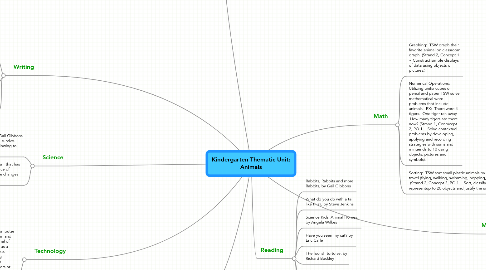Kindergarten Thematic Unit: Animals
создатель Jaymie Harnisch


1. Writing
1.1. TS and the teacher will write a thank you letter as a class to the zoo thanking them for allowing the class to visit all of the animals. Included in the letter will be information on the graph constructed in the classroom as to what their favorite animals are. (Strand 3, Concept 3, PO 2b. ~ Participate in writing communications, with teracher as scribe, including: thank-you notes)
1.2. TSW write about their favorite animal, including a description of the animal and their habitat. (Strand 1, Concept 2, PO1 ~ Communicate by drawing, telling, or writing for a purpose).
1.3. TSW write a story about their observations at the zoo through drawing and writing. (Strand 3, Concept 2, PO1, ~ Participate in creating expository texts (ex: observations, summaries) through drawing or writing).
2. Science
2.1. After teacher reads book Rabbits, rabbits, & more rabbits!, by Gail Gibbons TSW orally state to a classmate what animals need to grow and survive. (Strand 4, Concept 3, PO 2 ~ Identify that animals need the following to grow and survive: Food, water, air and space)
2.2. TSW describe the changes in classroom aquarium that has many fish inside of it through drawing a sequence of pictures. (Strand 4, Concept 3, PO 3 ~ Describe changes in a small system (ex: aquarium) ).
3. Technology
3.1. TSW pair up with their 8th grade computer buddies to utilize a drawing program and create a picture story about an animal of their choice and what it looked like as a baby and what it grew up to look like. (Standard 3, PO1 ~ Using a drawing program, create a picture story with support from teacher, family members or student partners).
4. Zoo field trip
4.1. Workplace skills
4.1.1. TSW discuss the correct behavior when they are on the bus to the zoo, and how to behave at the zoo when near the animals. Standard 5, 5WP-R3 ~ (Describe appropriate behavior for different settings e.g. on a bus, on a field trip)
4.2. Science
4.2.1. During the zoo field trip the students will describe in their own words how the baby animals physically resemble their parents. (Strand 4, Concept 2, PO 1 ~ Describe that most plants and animals will grow to physically resemble their parents)
4.3. Listening and Speaking
4.3.1. During lunch break at zoo TTW read I Want To Be A Zookeeper, by Dan Liebman. TSW discuss in small groups how they would take care of their favorite animal if they were a zookeeper (Standard 3, PO 4 ~ (Participate in group discussions)
